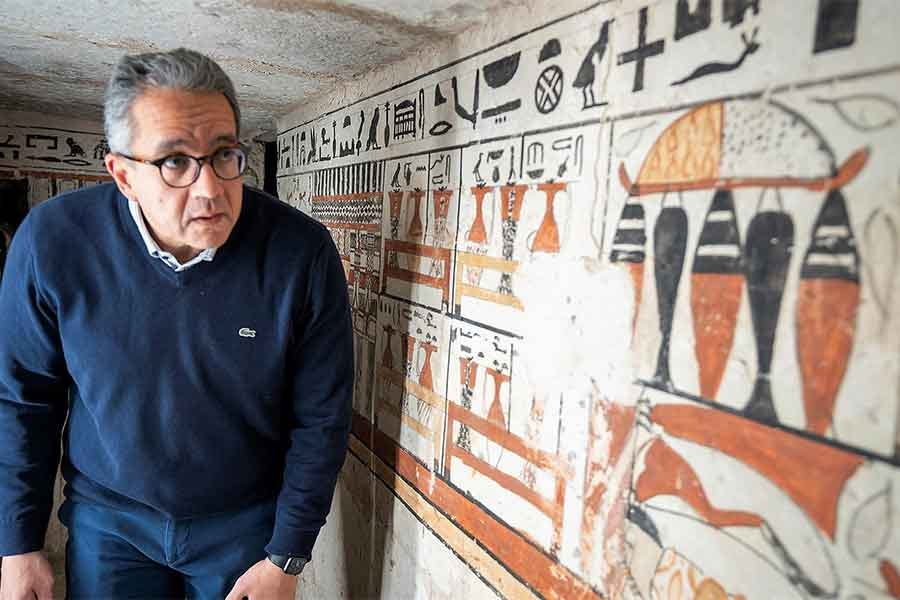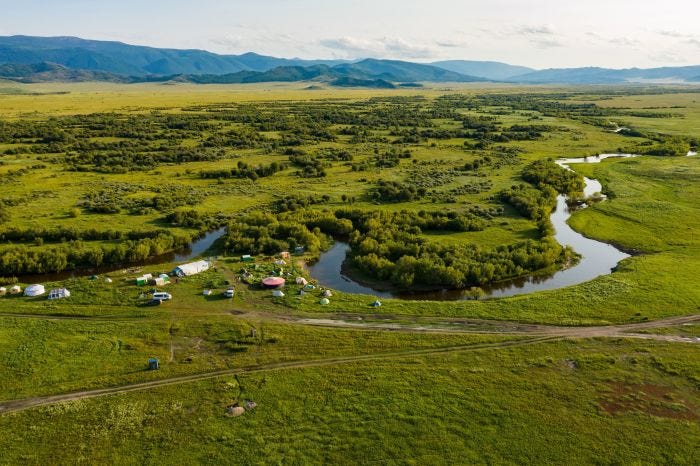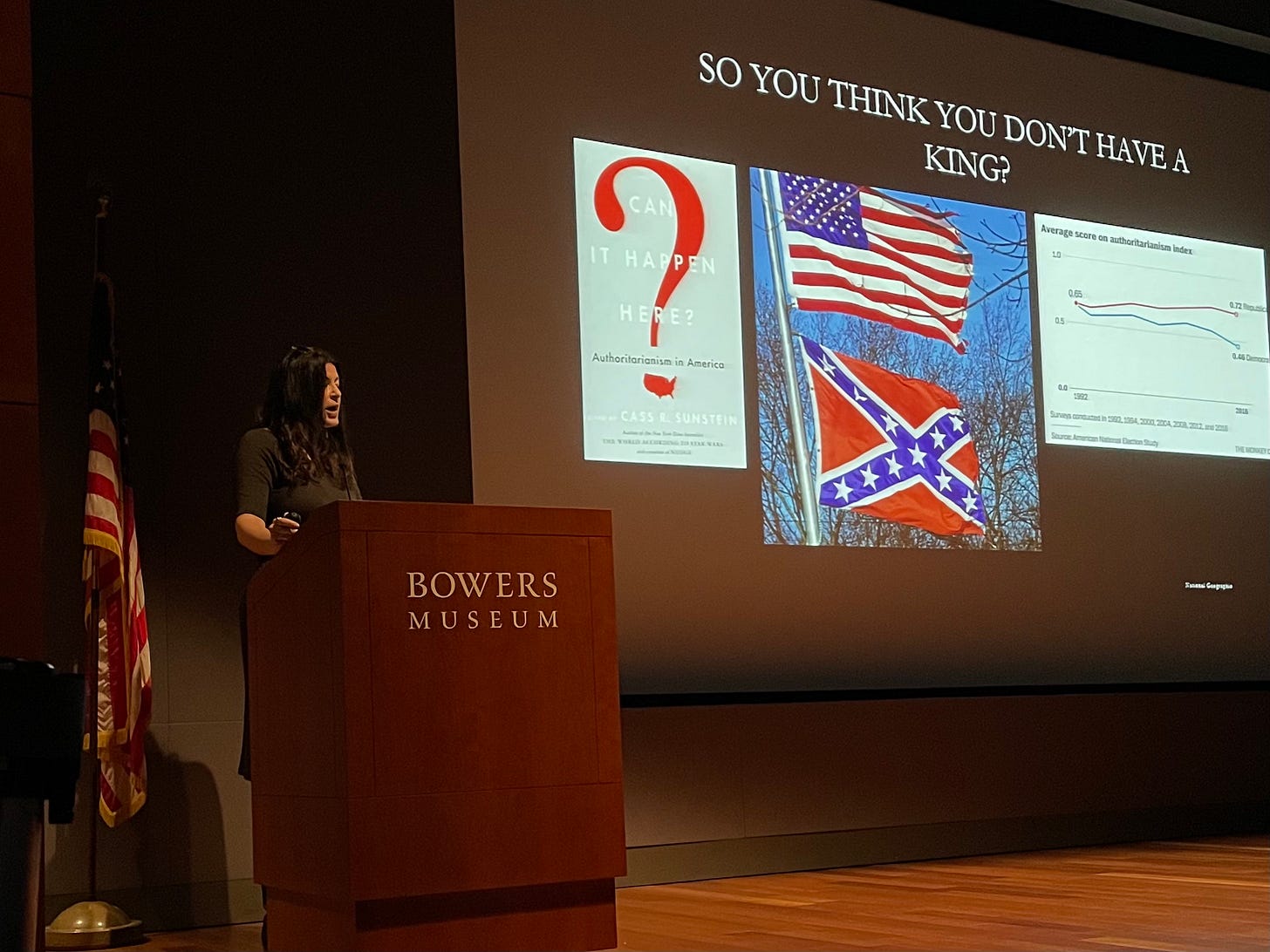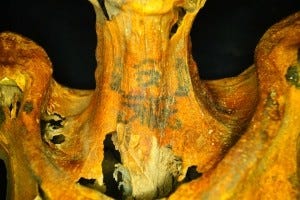Weekly Roundup - April 8th
Our favorite news stories and topics from this week - fashion, tattoos, new tombs, and much more!
Fashion Fashion, Historic Fashion!
With the Oscar’s Costume category full of historical dress and the Season 2 release of Bridgerton, fashion has been making its rounds. This brings up some questions—how should we understand the modern reception of historical dress? Does accuracy matter? What are the implications of blending historical fashions without contextualization? What about appropriation? What happens when we consume these visuals at face value? Here is one of our favorite takes from Twitter:


If you would like to read more about modern fashions interacting with the past, see Katherine Blouin’s “Walk like an Egyptian? How Modern Fashions Appropriates Antiquity” and Aimee Hinds’ “Couture and the Classics.” For a discussion of this topic as it directly related to Egyptology, see “How Academics, Egyptologists, and Even Melania Trump Benefit From Colonialist Cosplay” by Katherine Blouin, Monica Hanna, and Sarah E. Bond. You all know Jordan works on fashion and aesthetics in ancient Egypt and plans for a podcast on the topic:
I am hoping to record a podcast episode on Fashion in the Ancient World touching upon such topics as Orientalism and appropriation. What other themes would you like to see in such an episode? What questions do you have about fashion and clothing in the ancient world?
Five ancient Egyptian tombs uncovered in Saqqara
Five new beautifully decorated tombs were just uncovered in Saqqara. These tombs are unique in that they date to the end of the Old Kingdom and First Intermediate Period. Not many tombs from these dates are known, making them a welcomed addition to the corpus. On the walls we can see depictions of a palace facade, offering tables laden with funerary goods, and even the seven sacred oils. Kara particularly loves this kind of tomb:
I love such tombs because they show how later coffin decoration developed as a tomb space first. That means that coffins are mini tombs. I am actually working on an article right now called “Coffins as Tombs.” Super fascinating stuff…

Gold pectoral ornament and bronze mirror discovered in Siberian barrow
How do burial goods become gendered and how do archaeologists assign rank and status? A Polish-Russian team uncovered a skeleton of a woman with a gold pectoral ornament and bronze mirror in what is called the Siberian “Valley of the Kings” dating to the early Scythian period. Of particular interest was the sickle-shaped pectoral, which up to this point was only known from male graves. The site archaeologists believe that this woman held an important role in the community given her grave’s close proximity to a nearby “prince.” Does this explain the pectoral in her grave? Or perhaps she, herself, held a further important position? But clearly, these pectorals should no longer be viewed within this strict gendered paradigm.
And it makes one wonder: how many of the graves have been mis-identified as male when they might have belonged to females?
Oldest Known Proto-Hebrew Inscription from Mount Ebal Discovered
The Associated for Biblical Research (ABR) announced the discovery of a formulaic curse tablet using proto-Hebrew script and mentioning the god YHW- if this is true it would be the oldest proto-Hebrew inscription and also the oldest use of YHW. This announcement has come with a ton of skepticism (See Prof. Rollston’s take).
The press conference has been criticized for their lack of photographic evidence, the teams reading and translating of the supposed 40 letters, and their insinuation that the altar found was built by Joshua as mentioned in Deuteronomy 27 and Joshua 8.
We shall await the peer-reviewed article coming out later this year to get to the bottom of this scholarly debate. But the way this discovery has been used and manipulated teaches us that no archaeology is apolitical. History and archaeology are always political as they swirl about claims of place and past. Please remember this the next time someone tells you history is irrelevant!
What We Know About Women who Vote for Republicans and the Men who Don’t
Voter demographics are continually fascinating. Why do individuals sometimes vote against their own interests? Kara relates this to her public lectures:
I end my public National Geographic Live lectures with a discussion of stereotypical feminine emotion, why we have distrusted female power, and why it may be the only thing that stops us from harming others, or launching that missile or killing yourself and your family—because emotion brings empathy. Check out this study indicating that if we humans want to be self-serving we de-empathize ourselves, applying only anger and rage and disdain.
This Week in the Ancient Near East Podcast: Tattoo Who? Or, From Egypt with Ink
Who could ever say no to another podcast on ancient tattooing practices!?
This podcast covers who got tattooed in the ancient world and what role did it play? In some cultures, like ancient Greece, tattooing was mainly use as a form of punishment, but in other, like Egypt, we have more and more evidence of tattooing being linked to women and their (sexy! magical!) cultic roles. UCLA’s very own alumna Prof. Anne Austin has published widely on this subject and found some of the more recent evidence herself!
For further reading:
A. Austin et C. Gobeil, “Embodying the divine. A tattooed female mummy from Deir el-Medina”, BIFAO 116, 2017, p. 23-46, http://www.ifao.egnet.net/bifao/116/03/\
Ancient Smells reveals secrets of Egyptian Tomb
Researchers from the University of Pisa placed various sealed objects from the tomb of Kha and Merit, now housed in the Museo Egizio di Torino, into plastic bags to capture the volatile chemicals they released. These objects included sealed jars, cups, and food remains. They then used a mass spectrometer to analyze the components of the ‘smells.’ They found aldehydes and long-chain hydrocarbons, indicative of beeswax; trimethylamine, associated with dried fish; and other aldehydes common in fruits. This should help reconstruct the various original mortuary goods.
The Museo Egizio has a incredible virtual tour of the Kha and Merit tomb gallery. Check out that preserved food!

Reconstructing ancient sense-scapes is a growing trend within the field of archaeology. How can we understand better what ancient peoples experienced in the world around them?
What are we’re watching this week:
Kara is catching up on Outlander and has some thoughts:
I am watching the Season 4 of Outlander, and I am consistently shocked at the dehumanization of Indigenous and Black people embedded within the Zeitgeist of a growing Christian manifest destiny. Watching the formation of American White Supremacy is fascinating and super sad.
But I still get very upset at some inauthentic elements: like the modern agro-farmed red seedless grapes 🍇 treated as normal in Scotland in one episode. Such rare fruit would be such a treat, and those grapes would have been very different…
Here’s Amber’s take on some recent archaeologically-themed movies: (And yes, we will review Marvel’s Moon Knight—stay tuned!)
One of my favorite things to do on a day off is to go to the movies. Last weekend I caught two movies I’ve been meaning to see—Death on the Nile and The Lost City. If you go into it knowing what you’re signing up for, these flicks do not disappoint.
Death on the Nile has a great all-star cast led by Gal Gadot. Agatha Christie’s plot has more than enough twists and turns to keep the audience engaged. The movie is beautifully shot, but don’t see it for historical accuracy or an accurate reflection of early twentieth century Egypt—a lot of the beauty of the places and monuments you see in the film is CGI or film sets and exists only in the imagination. Even so, if you’re a fan of Christie’s classic novel or just a fan of detective stories, you don’t want to miss this movie.
The Lost City is a fun, light-hearted rom-com adventure with Sandra Bullock and Channing Tatum as entertaining leads. The echoes of Romancing the Stone, the 1984 action-adventure romance film with Kathleen Turner and Michael Douglas, are undeniable but in no way take away from the fun. If you want a little movie escape, this is the one. Just don’t overthink it. Although the plot involves a fictional lost South American civilization, the ancient art in the film is entirely imaginative and oddly resembles ancient Egyptian art. That said, don’t let your inner armchair archeologist keep you from letting go and enjoying this theatrical rollercoaster ride.










With regard to fashions of the ancient world, I would love to know more about the triangular kilt. What did it look like in real life? How was that shape achieved (with a matching crinoline?)? What was the significance of the garment? Did that change over time? How did they come up with it in the first place? Did it have to do with hiding or accentuating an errection? Are there any portrayals of women wearing it?
I am also curious as to the everyday practicality of the commonly shown women's garment that is shown as a sheath from the breasts to the feet. Did this garment restrict the ability to walk freely?